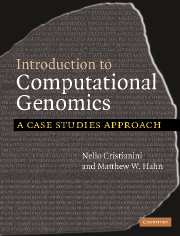Book contents
- Frontmatter
- Contents
- Preface
- Prologue: In praise of cells
- Chapter 1 The first look at a genome
- Chapter 2 All the sequence's men
- Chapter 3 All in the family
- Chapter 4 The boulevard of broken genes
- Chapter 5 Are Neanderthals among us?
- Chapter 6 Fighting HIV
- Chapter 7 SARS – a post-genomic epidemic
- Chapter 8 Welcome to the hotel Chlamydia
- Chapter 9 The genomics of wine-making
- Chapter 10 A bed-time story
- Bibliography
- Index
Chapter 7 - SARS – a post-genomic epidemic
Phylogenetic analysis
Published online by Cambridge University Press: 05 June 2012
- Frontmatter
- Contents
- Preface
- Prologue: In praise of cells
- Chapter 1 The first look at a genome
- Chapter 2 All the sequence's men
- Chapter 3 All in the family
- Chapter 4 The boulevard of broken genes
- Chapter 5 Are Neanderthals among us?
- Chapter 6 Fighting HIV
- Chapter 7 SARS – a post-genomic epidemic
- Chapter 8 Welcome to the hotel Chlamydia
- Chapter 9 The genomics of wine-making
- Chapter 10 A bed-time story
- Bibliography
- Index
Summary
Outbreak
On February 28, 2003 the Vietnam French Hospital of Hanoi, a private hospital with only 60 beds, called the World Health Organization (WHO) with a report of patients who had unusual influenza-like symptoms. Hospital officials had seen an avian influenza virus pass through the region a few years earlier and suspected a similar virus. The pathogen seemed highly contagious and highly virulent, so they asked that someone from the WHO be sent to investigate. Dr. Carlo Urbani, an Italian specialist in infectious diseases, responded.
Phylogenetic trees
The neighbor-joining algorithm
The Newick format for representing trees
Dr. Urbani quickly determined that the Vietnamese hospital was facing a new and unusual pathogen. The infections he observed were characterized by a fever, dry cough, shortness of breath, and progressively worsening respiratory problems. Death from respiratory failure occurred in a significant fraction of the infected patients. For the next several days, Dr. Urbani worked at the hospital documenting findings, collecting samples, and organizing patient quarantine. He was the first person to identify and describe the new disease, called Severe Acute Respiratory Syndrome, or SARS. In a matter of weeks, Dr. Urbani and five other healthcare professionals from the hospital would be dead.
By March 15 the WHO had already issued a global alert, calling SARS a “worldwide health threat.” They warned that possible cases had been identified in Canada, Indonesia, Philippines, Singapore, Thailand, and Vietnam.
- Type
- Chapter
- Information
- Introduction to Computational GenomicsA Case Studies Approach, pp. 110 - 127Publisher: Cambridge University PressPrint publication year: 2006
- 1
- Cited by



